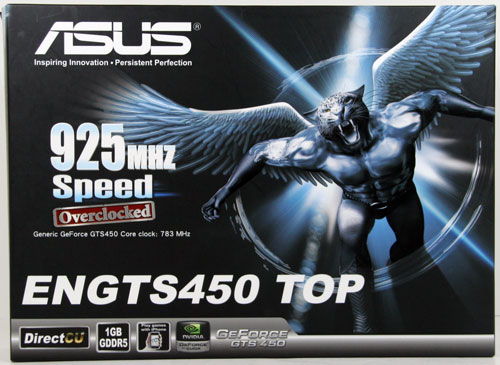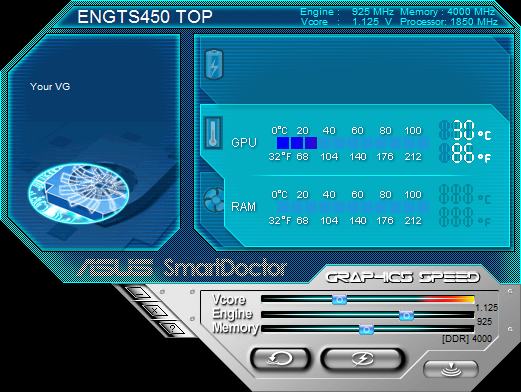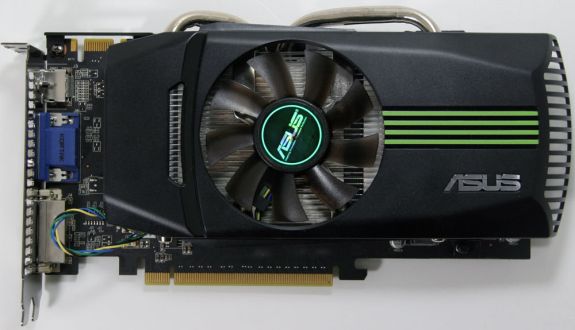NVIDIA GeForce GTS 450 Launch Roundup: Asus, EVGA, Palit, and Calibre Overclocked and Reviewed
by Ryan Smith on September 13, 2010 6:08 PM ESTAsus ENGTS450 Top
We’ll start our look at our vendor cards with the Asus ENGTS450 Top, Asus’s top-clocked entry in to our roundup. It’s one of the 3 heavily overclocked cards in our roundup, sporting a 925MHz core clock and a 1GHz (4GHZ effective) memory clock, a 142MHz (18%) and 98MHz (11%) overclock respectively.

The ENGTS450 Top comes from Asus’s Xtreme Design team and features their usual enhancements: a double-sealed “dust-proof” fan, double overcurrent protection, and as we previously mentioned structural enhancements to keep the PCB from bending. The card is also part of Asus’s Voltage Tweak series, meaning it’s been specifically augmented for overvolting. Compared to the reference GTS 450 Asus is using a different VRM setup with additional phases, which they claim offers superior power delivery. In any case the VRMs they’re using are certainly more capable than the VRMs on the reference cards; while our reference cards max out at 1.162v, the ENGTS450 Top can go to 1.212v. In practice this is likely more voltage than the card can handle with air cooling, so liquid cooling would be a necessity for pushing the card that hard.
Attached to the card is Asus’s custom dual-heatpipe DirectCU cooler, the same one we saw back in July on their custom GTX 460 card. Asus claims that it’s cooler and quieter than the reference cooler, and while it does do a better job of dissipating heat it’s not as quiet as NVIDIA’s near-silent reference cooler. Meanwhile at 8.25” the PCB is the same length as the GTS 450 reference PCB, but as with the GTX 460 the shroud on Asus’s DirectCU cooler sticks out a bit, making the card over 9” long for all practical purposes. Thankfully with its extra length Asus has moved the PCIe power socket compared to the reference board – on the ENGTS450 Top it’s on the top of the card rather than the rear.

Moving on, in terms of ports the ENGTS450 Top throws us for a bit of a loop. For the rest of the cards in this round you will see 2x DVI ports and a mini-HDMI port (just like NVIDIA’s reference design) but Asus has dropped the 2nd DVI port in favor of a VGA port. Keep in mind that the GTS 450 can only drive two monitors so this does not keep the card from driving a 2nd digital display, but we’re a bit lost on who would be using an analog monitor with a $140 video card. We can only assume this was so Asus could skip out on packing a DVI-to-VGA dongle with the card to save a few pennies.

As for the software side of things, the card comes packaged with Asus’s SmartDoctor and GamerOSD software, which are made necessary by the fact that this is a Voltage Tweak card and hence it needs software to allow tweaking. SmartDoctor and GamerOSD haven’t changed much in the last year, so our thoughts are the same as always: it gets the job done, but otherwise it’s glitch and unintuitive software that’s outclassed by 3rd party utilities. Normally SmartDoctor is the only software that can properly control the VRMs on an Asus card, but in this case MSI’s Afterburner software recognizes the VRMs so we honestly can’t think of a good reason to use SmartDoctor in this case. SmartDoctor is simply outclassed by Afterburner here.

Rounding out the package is the usual quick start guide, a double-molex to PCIe power adaptor, and a driver/utility CD.
Finally, for those of you wondering about the price, Asus has put the MSRP at $139, which means the card commands a $10 premium over a reference GTS 450. Out of all of the overclocked cards in our roundup today, this is actually the cheapest of them.











16 Comments
View All Comments
gwolfman - Monday, September 13, 2010 - link
When do we get our first single slot Fermi? I'd like one to offload my PhysX. Any ideas?Slash3 - Monday, September 13, 2010 - link
Looks like an error on the first page's chart, the memory clock box for the reference card should be at a 3.6GHz data rate and not 4.6GHz, correct?anactoraaron - Monday, September 13, 2010 - link
And their responce to the bending issue is why they are just the best to work with (and buy from) for anything - including RMA's. They are first in that category (customer service) hands down. Over the course of 7 years, I have had to RMA something (at least one item) to ASUS, HIS (the worst by far), Gigabyte and EVGA. EVGA FTW!Voldenuit - Monday, September 13, 2010 - link
Warping, like all of life's problems, is just a special case of bending.Shadowmaster625 - Tuesday, September 14, 2010 - link
You guys should simulate 2-3 months of heavy dust collecting inside a PC case. Then run the furmark power consumption and heat tests. Then you might understand why people want a card like the Calibre X450G.HangFire - Thursday, September 16, 2010 - link
2-3 months does not make for heavy dust in any of my PC cases. 2-3 years would, but none run that long before getting cleaned out.The real market for the Calibre would be the silent PC crowd, who would otherwise pay extra for an Accelero (or other aftermarket GPU cooler), and would be happy to pay a smaller premium for a pre-installed cooler- and keep their warranty too.
tech6 - Tuesday, September 14, 2010 - link
Since you can get a 5770 from NewEgg for $125 (with rebate) and GTX460 for $170, I don't see why any of these cards make much sense unless they will be heavily discounted.JPForums - Tuesday, September 14, 2010 - link
<quote>Since you can get a 5770 from NewEgg for $125 (with rebate) and GTX460 for $170, I don't see why any of these cards make much sense unless they will be heavily discounted. </quote>At $130 straight up these GTS450s make plenty of sense (especially if you don't want to deal with the sometimes less than reliable rebate system). They may not be quite as good a value as a $125 HD5770, but they are still a good buy. (particularly if you require an nVidia card) Of course, a GTX460 will net you a healthy performance boost for an equally healthy price bump.
Spazweasel - Tuesday, September 14, 2010 - link
They still do. Look in the part number. If it ends in "AR" it's lifetime warranty, if it's "TR" the warrant is (I think) 2 years. The price difference is generally 10 to 20 dollars, depending upon the base price of the part.shin0bi272 - Tuesday, September 14, 2010 - link
Id rather have a gtx470 super overclock from gigabyte. yeah its twice the price but its more than twice the speed. The gigabyte 470 soc out performs a gtx480 but costs 100 bucks less. So why go out and have to buy 2 450's to get halfway decent performance when you could buy 1 470 and spend the same amount?http://www.newegg.com/Product/Product.aspx?Item=N8...